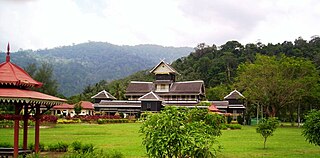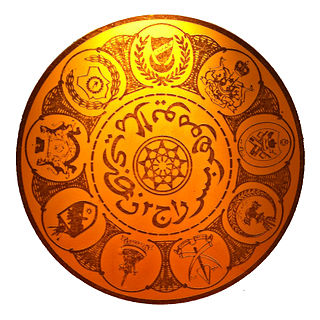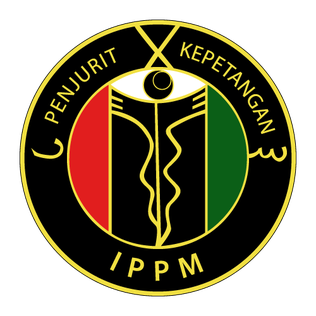
Negeri Sembilan, historically spelled as Negri Sembilan, is a state in Malaysia which lies on the western coast of Peninsular Malaysia. It borders Selangor on the north, Pahang in the east, and Malacca and Johor to the south.

The Undang Yang Empat are the ruling chiefs or territorial chiefs who still play an important role in the state of Negeri Sembilan, Malaysia, namely in the election of a new Yang di-Pertuan Besar. The name is believed to be derived from the Malay word undang-undang meaning "law".

Seri Menanti is a town, a mukim and a state assembly constituency in Kuala Pilah District, in central Negeri Sembilan, Malaysia, located 33 km east of the state capital city of Seremban and 14 km southwest of Kuala Pilah. It is the royal capital of the state of Negeri Sembilan and houses the seat of the Yang Di-Pertuan Besar of Negeri Sembilan or Yamtuan Besar, the ruler of the state of Negeri Sembilan. The royal palace is known as "Istana Besar".

Tampin is a town in Tampin District, Negeri Sembilan, Malaysia, which borders Pulau Sebang town in Alor Gajah District, Malacca. It is also situated at the southern tip of the longest mountain range in Malaysia, the Titiwangsa Mountains, from a geographical standpoint.

This article lists important figures and events in Malaysian public affairs during the year 1986, together with births and deaths of notable Malaysians.

Johol is a town, a mukim and a state assembly constituency in Kuala Pilah District, Negeri Sembilan, Malaysia. It is roughly halfway between Tampin and Kuala Pilah, along FT 9.

Yamtuan, also known officially as Yang di-Pertuan Besar and unofficially as Grand Ruler, is the royal title of the ruler of the Malaysian state of Negeri Sembilan. The Grand Ruler of Negeri Sembilan is elected by a council of ruling chiefs in the state, or the Undangs. This royal practice has been followed since 1773. The Yamtuan Besar is elected from among the four leading princes of Negeri Sembilan ; the Undangs themselves cannot stand for election and their choice of a ruler is limited to a male Muslim who is Malay and also a "lawfully begotten descendant of Raja Radin ibni Raja Lenggang", the 4th Yamtuan.

Tuanku Sir Muhammad Shah ibni Almarhum Tuanku Antah was the seventh Yamtuan Besar of Seri Menanti, who ruled from 1888 to 1933. During his reign, Negeri Sembilan came under British protection in 1889 and became a Federated Malay State in 1895.

The Overseas Minangkabau is a demographic group of Minangkabau people of Minangkabau Highlands origin in Central Sumatra, Indonesia who have settled in other parts of the world. Over half of the Minangkabau people can be considered overseas Minangkabaus. They make up the majority of the population of Negeri Sembilan and Pekanbaru. They also form a significant minority in the populations of Jakarta, Bandung, Medan, Batam, Surabaya and Palembang in Indonesia as well as Kuala Lumpur, Malacca, Penang, Singapore and Brunei Darussalam in the rest of the Malay world. Minangkabaus have also emigrated as skilled professionals and merchants to the Netherlands, United States, Saudi Arabia and Australia. The matrilineal culture and economic conditions in West Sumatra have made the Minangkabau people one of the most mobile ethnic group in Maritime Southeast Asia.
The flag and the coat of arms of Negeri Sembilan are state symbols of Negeri Sembilan, Malaysia. The symbols are predominantly depicted in red, black and yellow, traditional colours of the Minangkabau people who are the original settlers in the present-day state. Also recognised in the symbols are the political history of Negeri Sembilan, its ruler, and the state's past relationship with the British Empire.

The monarchies of Malaysia refer to the constitutional monarchy system as practised in Malaysia. The political system of Malaysia is based on the Westminster parliamentary system in combination with features of a federation.
Negeri Sembilan Malay is an Austronesian language spoken mainly in the Malaysian state of Negeri Sembilan and in northern Malacca in Alor Gajah. The language is spoken by the descendants of Minangkabau settlers from Sumatra, who have migrated to Negeri Sembilan since as early as the 14th century. It is often considered a variant or dialect of the Minangkabau language; lexical and phonological studies, however, indicate that it is more closely related to Standard Malay than it is to Minangkabau.

Istiadat Pewaris Penjurit-Kepetangan Melayu or formerly known as Ilmu Persilatan Penjurit-Kepetangan Melayu, shortform IPPM is one of the oldest original known to date Malay martial art form or called 'Silat' in existence which has been heritage from one generation to another. Descended from the first ruler of the Malayapura Kingdom, King Adityawarman whom is also known as Seri Maharaja Diraja which to a later stage sparked the start of Minangkabau history in Pagaruyung Kingdom, Sumatra, Indonesia. These story has been greatly narrated in most of old Malay Literature including in of the most reliable sources to date called Sulalatus al-Salatin or better known as The Malay Annals (Malay: Sejarah Melayu). The manuscript begin with the stories of Wan Malini and Wan Empuk whom was presented with 3 adopted princes right after when their rice fields was magically expelling gold. These 3 princes was later mark as the kickstart for the next 3 big empires in Malay Archipelago. Those empires were the Kingdom of Majapahit, The Malacca Sultanate and the Pagaruyung Kingdom around the 12th century.

The Indonesian Malaysians are Malaysian citizens of Indonesian ancestry. Today, there are many Malaysian Malays who have lineage from the Indonesian archipelago and have played an important role in the history and contributed to the development of Malaysia, they have been assimilated with other Malay communities and are grouped as part of the foreign Malays or anak dagang in terms of race. The Malaysian census does not categorize ethnic groups from the Indonesian archipelago as a separate ethnic group, but rather as Malay or Bumiputera.
Paduka Sri Sultan ‘Abdu’l Jalil IV Ri’ayat Shah Zillu’llah fi al-’Alam bin Dato’ Bendahara Sri Maharaja Tun Habib Abdul Majid was the Sultan and Yang di-Pertuan Besar of Johor and Pahang and their dependencies, who reigned from 1699 to 1718.
Tuanku Antah ibni Almarhum Yamtuan Radin (1812–1888) was the sixth Yamtuan Besar of Negri Sembilan. He ruled from 1869 to 1888, and tried to keep Negri Sembilan independent from British rule. His son Tuanku Muhammad Shah succeeded him and modernised his state.

The Rembau District is a district that is located in the state of Negeri Sembilan, Malaysia. The district is a stronghold of the matrilineal system known as adat perpatih, a customary practice inherited from the Minangkabaus, of Sumatra. The district borders Seremban District to the north, Port Dickson District to the west, Tampin District to the east, Kuala Pilah District to the northeast and Alor Gajah District, Malacca to the southwest.
The following is the family tree of the Malay monarchs of Negeri Sembilan, from the establishment of the chieftaincy in 1773 until present day. The monarch is styled Yang di-Pertuan Besar or shortened as Yamtuan Besar. The first three monarchs namely, Melewar, Hitam and Lenggang were hailed from Pagaruyung in Sumatra, and were invited to rule the confederacy of Minangkabau Luaks of Negeri Sembilan. The accession of the locally-born Radin marked the end of the practice of inviting princes from Pagaruyung.

The Minangkabau Malaysians are citizens of the Malaysia whose ancestral roots are from Minangkabau of central Sumatra. This includes people born in the Malaysia who are of Minangkabau origin as well as Minangkabau who have migrated to Malaysia. Today, Minangkabau comprise about 989,000 people in Malaysia, and Malaysian law considers most of them to be Malays. They are majority in urban areas, which has traditionally had the highest education and a strong entrepreneurial spirit. The history of the Minangkabau migration to Malay peninsula has been recorded to have lasted a very long time. When the means of transportation were still using the ships by down the rivers and crossing the strait, many Minang people migrated to various regions such as Negeri Sembilan, Malacca, Penang, Kedah, Perak, and Pahang. Some scholars noted that the arrival of the Minangkabau to the Malay Peninsula occurred in the 12th century. This ethnic group moved in to peninsula at the height of the Sultanate of Malacca, and maintains the Adat Perpatih of matrilineal kinships system in Negeri Sembilan and north Malacca.

















